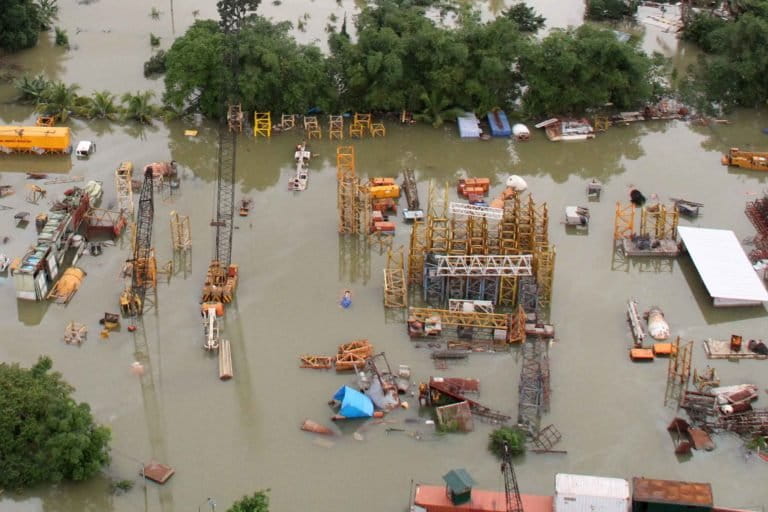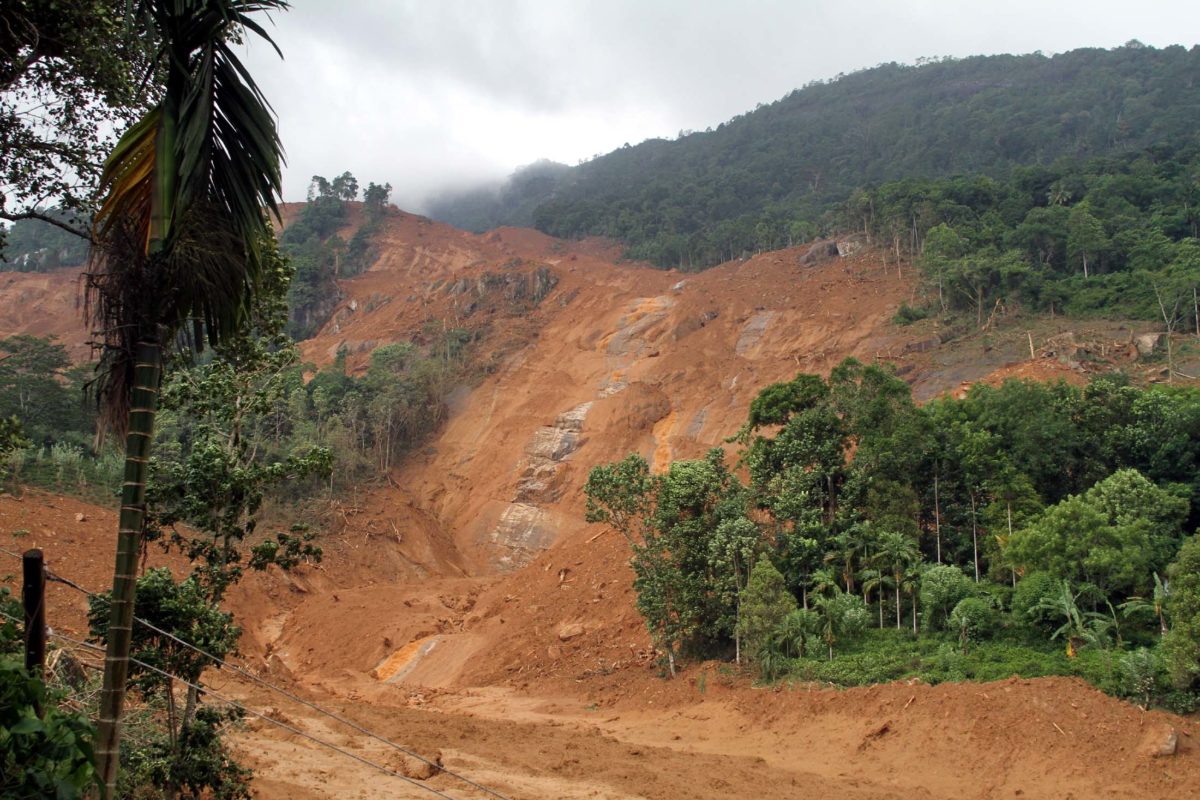- New assessments identify Sri Lanka’s northern region as a hotspot for climate change impacts, with the district of Jaffna named the top hotspot.
- The Global Climate Risk Index 2019 lists Sri Lanka as the second most impacted country in 2017 for having faced extensive losses due to climate catastrophes in a single year.
- With extreme weather events predicted to increase with rising levels of impact, the assessments call for rapid adaptation, particularly in terms of livelihoods vulnerable to an increasingly unpredictable climate.
JAFFNA, Sri Lanka — For Nataraja Kumar, 47, a fisherman from Guru Nagar, a sleepy coastal village in Sri Lanka’s north, it’s no longer possible to continue with his traditional livelihood.
“I went fishing as a 10-year-old boy with my father and grandfather. But I will not train my son to be a fisherman. There’s no fish to catch,” he tells Mongabay.
Fishing is Kumar’s only life skill, and he has five mouths to feed. Having failed to eke out a living in the past two years as a fisherman, Kumar is now slowly letting go of his traditional livelihood to work as a day laborer at a construction site in another town, earning around $3 a day to keep food on the table. Many other fishermen, he says, are making the same switch.
“The sea seems to have changed. We find less [fish] and fewer species,” Kumar says, adding that the northern waters no longer yield the highly popular black tiger prawns, a top seafood export.
It’s the same story for those engaged in growing traditional crops, like onion farmer Sudhiran Kanapathipillai, 51, from Jaffna, the capital of Sri Lanka’s Northern Province.
For three consecutive seasons, his crops have failed due to unpredictable weather. “We cannot rely on wet and dry spells any longer. They just don’t happen that way,” he tells Mongabay. “Paddy farmers suffer more than us due to their dependence on the monsoon pattern. North was once agriculturally productive. Our soil is good but the weather has failed us.”
The island’s north is feeling the heat – literally – with two separate studies highlighting Sri Lanka’s increased risk to changing weather patterns that are driving extensive changes in both living standards and livelihoods.
Increasing climate risks
A briefing paper titled the Global Climate Risk Index 2019 published by Germanwatch looks at the impacts of weather-related loss events such as storms, floods and heat waves from 1998 to 2017. It ranked Sri Lanka as the second most impacted territory in 2017.
In 2015, Sri Lanka ranked 98th, but made a swift jump to the second slot two years later after the island suffered extensive losses, both in terms of deaths and property damage, from a series of exceptional catastrophes.
In May 2o17, heavy landslides and floods hit Sri Lanka after strong monsoon rains in the country’s southwest. More than 200 people died in the worst rains experienced on the island since 2003. The extreme weather displaced more than 600,000 people and affected 12 out of 25 districts.

The Sri Lankan experience corresponds well to the findings of the Fifth Assessment Report of the U.N.’s Intergovernmental Panel on Climate Change (IPCC), which predicts an increase in risks associated with extreme weather events as global mean temperatures rise, also linking global warming to El Niño events.
Smart agriculture and alternate livelihoods
On the ground, communities are now being asked to deal with the reality, not as individuals but as entire communities.
S. Sivakumar, director of the department of agriculture at the Northern Provincial Council, says these are among the “hot” issues faced by the provincial administration.
“As weather turns extremely unpredictable and extreme weather events are causing repeated crop failure in a region that was battered by nearly three decades of war, it is a fight against poverty which requires a new approach toward ensuring food security and livelihoods,” he told Mongabay.
Sivakumar says that the inadequacy and unpredictability of rainfall, coupled with prolonged spells of drought, are affecting traditional livelihoods such as fishing and agriculture. “We recommend smart agriculture and the reintroduction of ancient systems such as the water cascading system Sri Lanka was once known for,” he said.
“Through pilot projects on ‘climate smart integrated agriculture’ in the three northern districts of Jaffna, Vavuniya and Kilinochchi, we promote solutions to overcome impacts climate change.”
But it’s not that easy for a region that was once a hotbed of ethnic violence to make that journey toward normalcy while battling against weather events that pose a new challenge.
The challenge before Sri Lanka, and the island’s north in particular, is well documented in a September 2018 World Bank Group study that looked into South Asia’s climate profiles, analyzing how temperatures have risen considerably and will continue to rise, with precipitation patterns becoming less predictable.
“Sri Lanka’s proximity to the ocean makes it vulnerable to increase in extreme tropical storms and sea level rise,” the study says. It says the country also contains “hidden hotspots,” areas that are economically at risk from climate change that are not often discussed. It adds that by 2050, annual average temperatures on the island are projected to increase by about 1 to 1.5 degrees Celsius (1.8 to 2.7 degrees Fahrenheit) under a climate-sensitive scenario, and 1 to 2 degrees Celsius (1.8 to 3.6 degrees Fahrenheit) under a carbon-intensive scenario.
The study says Sri Lanka has 19 million people living in locations that would become “moderate or severe hotspots” by 2050 under the carbon-intensive scenario, or more than 90 percent of the total population.
And if the projection holds true, Sri Lanka’s Northern and North Western provinces will emerge as the top hotspots.
The island’s north, home to a large population of poor and displaced communities, will have to bear the brunt of the vagaries of the weather, adding a new challenge to its long-term recovery, the country snapshot says.
As such, Jaffna will become the top hotspot, followed by Puttlam in North Western province, followed by Mannar and Kilinochchi in Northern province, making the island’s north highly vulnerable.
Likewise, Western province too is projected to be highly impacted, with a decline in living standards of about 7.5 to 8 percent, including in Colombo, Sri Lanka’s economic hub that contributes over 40 percent of the country’s GDP.
The projections call for drastic changes in traditional livelihoods and for urgent economic adaptation.
With a projected decline in living standards of 1 to 7 percent, it is suggested that non-agricultural jobs will shoot up by 30 percent, marking a huge shift from the agriculture-based rural economy and livelihood patterns.
Adaptation and mitigation
Measures are being taken to mitigate impact caused by extreme weather events, even as adaptation holds the key, says the director of Sri Lanka’s Climate Change Secretariat (CCS), R.D.S. Jayathunga.
He told Mongabay the actual problem lay with the increase in the nighttime temperature fluctuations, impacting a multitude of crops and reducing agricultural productivity, making it a main focus of the country’s national policy and the adaptation plan to combat climate change impact.
Sri Lanka needs to improve its resilience through targeted programs, he said, identifying future challenges such as agriculture, heat stress, indirect health impacts and biodiversity loss. “We need to be ready as a resilient nation,” Jayathunga said.
Banner image of Aranayake, a hilly village on the fringes of Sri Lanka’s North Central province, where extensive flooding caused by the monsoon in May 2016 killed more than 100 people and affected 22 out of 25 districts. Image courtesy of the Sri Lanka Army.
